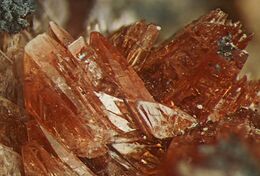Chemistry:Allactite
From HandWiki
| Allactite | |
|---|---|
 Picture width 3 mm | |
| General | |
| Category | Arsenate mineral |
| Formula (repeating unit) | Mn7(AsO4)2(OH)8 |
| Strunz classification | 8.BE.30 |
| Dana classification | 41.2.1.1 |
| Crystal system | Monoclinic |
| Crystal class | Prismatic (2/m) (same H-M symbol) |
| Space group | P21/a |
| Unit cell | a = 11.03, b = 12.12 c = 5.51 [Å], β = 114°, Z = 2 |
| Identification | |
| Color | Brown, dark to light purplish red, brownish red, colorless to white |
| Crystal habit | Elongated prisms, bladed, tabular, rosette-like aggregates |
| Cleavage | Distinct, {001} |
| Fracture | Uneven |
| Tenacity | Brittle |
| Mohs scale hardness | 4.5 |
| |re|er}} | Vitreous, slightly greasy on fracture surfaces |
| Streak | Gray to faint brown |
| Specific gravity | 3.83 (meas.), 3.94 (calc.) |
| Optical properties | Biaxial (−) |
| Refractive index | nα = 1.755–1.761 nβ = 1.772–1.786 nγ = 1.774–1.787 |
| Pleochroism | X = blood-red; Y = pale yellow; Z = sea-green |
| 2V angle | ~0° |
| References | [1][2][3] |
Allactite is a rare arsenate mineral of metamorphosed manganese zinc ore deposits. It is found in Sweden and New Jersey, US. Its name originated from Greek αλλάκτειν (allaktein) meaning "to change", referring to the strong pleochroism of the mineral.[2]
References
- ↑ Allactite. Mindat
- ↑ 2.0 2.1 Allactite. Handbook of Mineralogy
- ↑ Moore P. (1968). "Crystal chemistry of the basic manganese arsenate minerals: II. The crystal structure of allactite". American Mineralogist 53: 733–741. http://www.minsocam.org/ammin/AM53/AM53_733.pdf.
- ↑ Warr, L.N. (2021). "IMA–CNMNC approved mineral symbols". Mineralogical Magazine 85 (3): 291–320. doi:10.1180/mgm.2021.43. Bibcode: 2021MinM...85..291W.
Bibliography
- Palache, P.; Berman H.; Frondel, C. (1960). "Dana's System of Mineralogy, Volume II: Halides, Nitrates, Borates, Carbonates, Sulfates, Phosphates, Arsenates, Tungstates, Molybdates, Etc. (Seventh Edition)" John Wiley and Sons, Inc., New York, pp. 785-787.
 |

